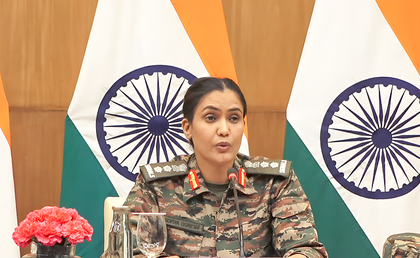India's strategic commitment to women in uniform: A new chapter in global peacekeeping
By IANS | Updated: August 24, 2025 16:25 IST2025-08-24T16:18:20+5:302025-08-24T16:25:16+5:30
New Delhi, Aug 24 India today stands at a pivotal juncture in its defence and diplomatic trajectory -- ...

India's strategic commitment to women in uniform: A new chapter in global peacekeeping
New Delhi, Aug 24 India today stands at a pivotal juncture in its defence and diplomatic trajectory -- where the empowerment of women in uniform is no longer aspirational rhetoric but a calibrated reality, embedded within the operational doctrine of the armed forces and the nation's global peacekeeping mandate.
This evolution was powerfully underscored during "Operation Sindoor", a precision military response following the April 22 terror attack in Jammu and Kashmir's Pahalgam.
In a moment of deliberate symbolism and strategic clarity, Wing Commander Vyomika Singh of the Indian Air Force and Colonel Sofiya Qureshi of the Corps of Signals were entrusted with leading the official briefing.
Their presence was not ceremonial -- it was operational.
Wing Commander Singh, a seasoned helicopter pilot with more than 2,500 hours in high-risk terrains, and Colonel Qureshi, the first woman to command an Indian Army contingent at the Force 18 exercise, exemplify the calibre of leadership now emerging from India's women officer cadre.
The naming of the operation -- "Sindoor" -- in honour of the women widowed in the attack, and the decision to place women officers at the forefront of India's military response, reflect a profound shift in institutional ethos.
Women are no longer peripheral to India's defence narrative; they are central to its execution and its symbolism.
This transformation is backed by policy and precedent.
From 3,000 women officers in 2014 to more than 11,000 today, the Indian Armed Forces have expanded access to combat aviation, naval operations -- including submarines -- and permanent commissions across services.
The Supreme Court's directive on permanent commission has dismantled structural barriers, enabling women to pursue full career tenures with parity in command and responsibility.
India's leadership extends beyond its borders.
As one of the largest contributors to UN Peacekeeping Operations, India has consistently deployed women in military, police, and civilian roles.
From the pioneering all-female police unit in Liberia in 2007 to Major Radhika Sen's recognition as the UN's Military Gender Advocate of the Year 2023, Indian women peacekeepers have redefined the role of gender in conflict resolution and community engagement.
The ongoing United Nations Women Military Officers Course (UNWMOC-2025), hosted in New Delhi with participation from 15 nations, further cements India's role as a global standard-bearer in gender-integrated military leadership.
This initiative is not merely instructional -- it is strategic capacity-building, rooted in India's lived experience and operational credibility.
India's model is not symbolic. It is constitutional, structural, and mission-driven.
Women officers are commanding troops, flying combat missions, leading covert operations, and shaping peacekeeping doctrine.
Their presence is not a gesture -- it is a force multiplier.
To global defence establishments and peacekeeping institutions, India offers a compelling blueprint: gender parity is not a concession -- it is a strategic imperative.
Empowerment, when institutionalised, enhances operational effectiveness, fosters trust in conflict zones, and strengthens the moral architecture of military leadership.
India's women in uniform are not just breaking barriers -- they are redrawing the map of what leadership looks like in the 21st century. And in doing so, they are not only securing the nation -- they are shaping the future of global peace.
Disclaimer: This post has been auto-published from an agency feed without any modifications to the text and has not been reviewed by an editor
Open in app